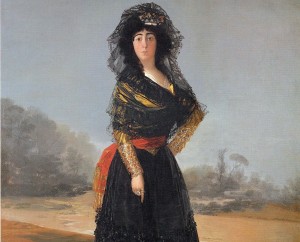The Duchess of Alba Is Alive and Well on Audubon Terrace
One hundred and eight years ago, American philanthropist Archer Milton Huntington (1870-1955) founded the Hispanic Society of America in a beautiful Beaux Arts building at 155th and Broadway in New York City. Today, through the passion and inspiration of that one man, the size, depth, and breadth of the collections are unparalleled to those outside the Iberian Peninsula. Art and artifacts from Spain, Portugal and Latin America abound, and the free rare books library maintains 15,000 books printed before 1700, including a first edition of Don Quixote.
Who is this man who amassed not only more than 18,000 works of art in nearly every conceivable medium from the Paleolithic era through the early 20th century, but who was perhaps more in love with the Duchess of Alba, or at least her image, than Goya himself?
THE DUCHESS
To find the answer, I needed to start at the source: the Mourning Portrait of Maria del Pilar Teresa Cayetana de Silva-Alvarez de Toledo, more commonly known as the 13th Duchess of Alba. This 1797 portrait rests on the facing wall of the main inner court as you first enter. She immediately catches the eye, in her proud elbow on hip stance, before you can even take in the rest of the magnificent interior with its burnt orange walls and dark wood balcony that rings the room. One thing’s for certain. The lady in the painting is a self-possessed 35-year-old woman of great bearing, and from her posture, the only thing in mourning appears to be the swirling black lace of the dress itself.
Was Goya romantically involved with the Duchess?
“Maybe, but it’s a mystery,” Mencia Figueroa, my gracious and well-versed guide assured me. She indicated the two rings on the subject’s fingers, one saying “Alba” while the other, her index finger, pointing to an inscription in the dirt at her feet. It reads, “Solo Goya.” Only during a 20th century cleaning was the writing discovered, making many wonder if the portrait was meant solely for Goya’s eyes.
“Another mystery,” Figueroa said. Nevertheless, Goya kept the painting in his possession until his death. In one of his letters in Sarah Symmons’ biography of the artist, Goya describes how the Duchess “came to the studio to make me paint her face, and she got her way. I certainly enjoy it more than painting on canvas, and I still have to do a full-length portrait of her.”
But how did it come into Huntington’s hands?
My guide described the rule of patrimony that prevailed in Spain during Huntington’s many visits and how respectful he was in his relationships with the families who possessed great art. “It could stay within the family [as a national treasure],” she explained, “but it could not be taken out of the country.” When Goya was exiled, he went to France, and Huntington supposedly bought the painting in Bordeaux.
But it wasn’t until a few years ago that generations of Spaniards who had never laid eyes on this image of the Duchess were granted a viewing. The museum arranged to loan it out to the Prado in Madrid and display it alongside Goya’s twin masterpiece that he painted for public consumption, The White Duchess. In that image, the Duchess appears more innocent, with her tiny white dog at her feet. As we ventured away from the painting, Figueroa emphasized what an auspicious event this exhibit was, and how people came from all over Spain and points beyond to see the portraits.
THE COLLECTOR AS YOUNG MAN
Huntington was the only son of one of the wealthiest men in America, Collis Potter Huntington, builder of the Central Pacific Railroad and the Newport News Shipbuilding Company. Their private life and finances were carefully guarded, and it was only through the son’s private diaries and correspondence that his early fascination with the Hispanic world and plans for a “Spanish museum” became known. My guide revealed that Archer Huntington had tried to burn many of his notes at one time, but his mother and confidante was instrumental in safeguarding them.
He was a precocious 12-year-old, beginning his collection of rare coins during his first trip to Europe; a collection which would eventually lead to the finest in the world, encompassing 35,000 coins and 3,500 medals covering the entire numismatic history of Iberia and Latin America. By the still tender age of 20, his library contained almost 2,000 books. To his mother, he confided, “The museum must condense the soul of Spain into meanings, through works of the hand and spirit…I wish to know Spain as Spain and so express her—in a museum.”
In early adulthood, during his many trips to Europe, his searches continued. His later purchases from the Golden Age (1550-1700) left nothing to chance. Diego Velasquez and El Greco have become mainstays of the collection, with paintings such as El Greco’s St. Jerome, among others, as well as works by Francisco de Zurbaran, Ribera, Murillo and others, in the 17th century.
(Article continued on next page)

